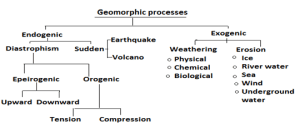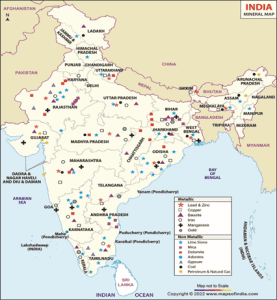Ans.
APPROACH
Introduction- Define geomorphic processes with classification and examples in brief.
The Body
- Begin with the definition of endogenic and exogenic forces. Discuss in detail the role of geological processes with respect to specific minerals.
- Bring out clearly the relation between exogenic or endogenic processes and mineral concentration.
- Draw the associated NCERT map showing the mineral wealth of India.
Conclusion- Briefly write how geological processes shape the face of the earth and mineral distribution. Highlight the need to understand such geological history of each mineral before undertaking their exploration and utilisation.
Introduction: Geomorphic processes can be defined as the endogenic and exogenic forces which shape the earth’s surface by causing physical stresses and chemical actions on earth materials. Diastrophism and volcanism are endogenic geomorphic processes, while exogenic processes comprise weathering, mass wasting, erosion and deposition.
The Body:

ENDOGENIC PROCESSES: Such processes are driven by the energy emanating from within the earth. This energy is generated due to radioactivity, rotational and tidal friction and primordial heat from the origin of the earth.
EXOGENIC PROCESSES: The energy from the atmosphere (with the sun as its ultimate source) and gradients created by tectonic factors result in exogenic processes. These forces tend to develop shear stress within the earth’s materials, which shapes the landscape of the earth under the action of agents such as running water, winds, glaciers, groundwater, etc.
ROLE OF GEOMORPHIC PROCESSES IN MINERAL FORMATION:
- Coal- Coalification and carbonization began during the Carboniferous period when the earth was covered with dense forests and shallow seas. The seas acting as an exogenic force caused the flooding of forested areas and trapped the dead organic matter at the bottom of a swamp. This organic matter buried deep within the earth’s surface was subjected to high temperature and pressure conditions as influence of endogenic forces. These endogenic processes in anaerobic environments caused the compression and transformation of dead organic matter into coal (peat bogs).
Such coal seams are found in the USA, Chotanagpur plateau(India), Russia, China and other countries.
- Placer deposits- Their formation starts with the process of weathering, which is an exogenic process. Placer deposits are masses of unconsolidated and semi-consolidated clastic material formed by surface weathering and erosion of primary rocks. The eroded material is then transported by gravity, water, wind or ice (all of which are exogenic forces) from their original source and redeposited elsewhere.
The placer deposits are rich sources of gold, platinum group minerals, monazite, zircon and rutile. Monazite sands rich in thorium and uranium are found on the eastern coast of India.
- Copper- The formation of copper ore deposits involves complex geological processes. The endogenic processes include hydrothermal activity and magmatic intrusions as effects of plate tectonics and volcanism. The high temperatures of the magma result in the formation of hydrothermal veins, which allow some heat to extrude into the earth’s crust and cause the accumulation of copper deposits in oxidized zones within sedimentary and volcanogenic rocks within a variety of geologic environments.
Copper is often found in deposits with other metals such as lead, zinc, gold and silver. In India, copper deposits are distributed in Khetri belt (Rajasthan), Singhbhum belt (Jharkhand) etc.
- Iron- Metallic minerals such as iron, manganese, nickel etc. are found in sedimentary and metamorphic rocks. Iron ore can occur in different geological formations, such as banded iron formations, sedimentary iron ore deposits, and magmatic-hydrothermal deposits. The role of endogenic forces such as volcanism and extrusion of magma and its subsequent solidification within the earth’s crust is significant. The igneous and sedimentary rocks containing oxides of iron undergo transformation into metamorphic rocks under conditions of extreme temperature and pressure.
Such conditions prevailed in the Chotanagpur plateau and Deccan traps in India, where hematite and magnetite iron ores are found.
- Sand and conglomerates- The role of exogenic forces is prominent in sand formation, which begins with the weathering of rocks (like quartz and feldspar) and their subsequent erosion by rivers down the slope and on plains. The eroded material is transported and deposited by the running water during its course. Depending on the size and shape of the material, the rivers assort the material during transportation, with the finer particles finally accumulated as sand.
Conglomerates are clastic sedimentary rocks which form in a similar manner. They are larger pieces of sediments comprising sand and pebbles whose deposition takes place in shallow waters under the influence of exogenic agents.

Conclusion:
The endogenic and exogenic forces are continuously in play and have been shaping not only the landforms on Earth but are also influencing the formation and spatial, temporal distribution of minerals. Understanding of the geological history of minerals becomes vital to study and map minerals and ensure their proper extraction using suitable technology.
Spread the Word
